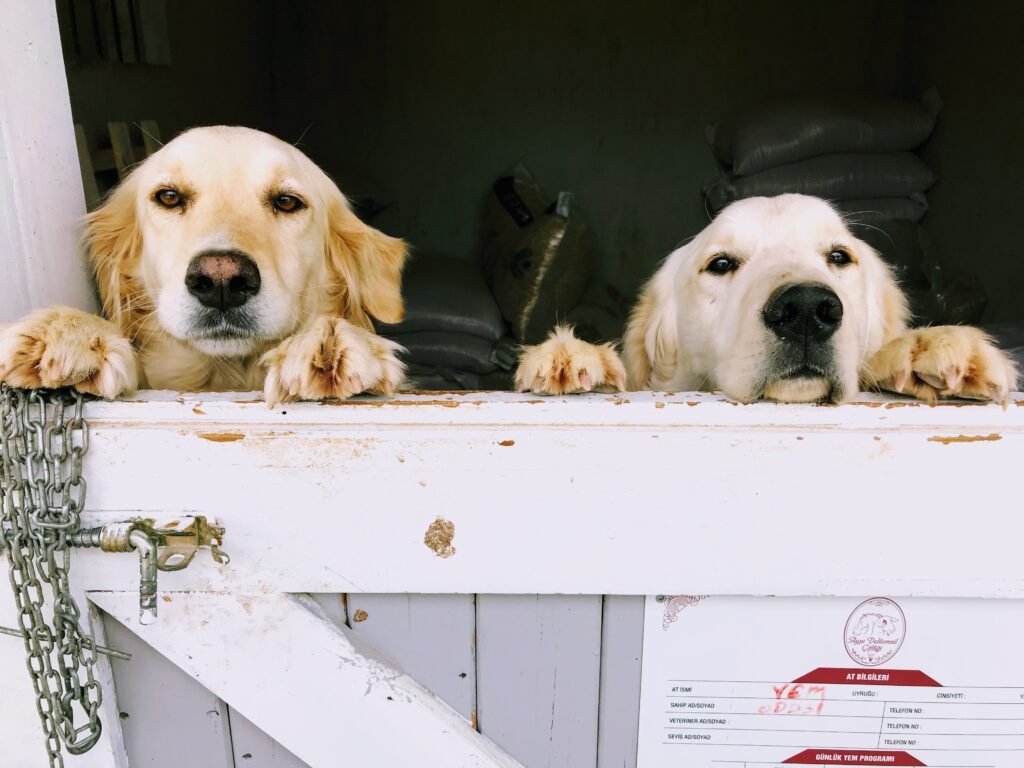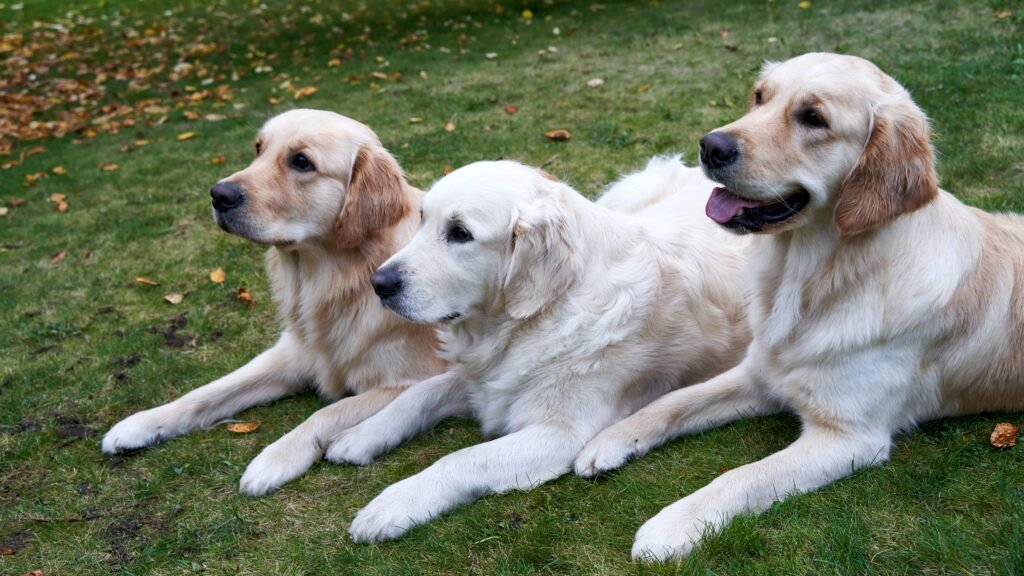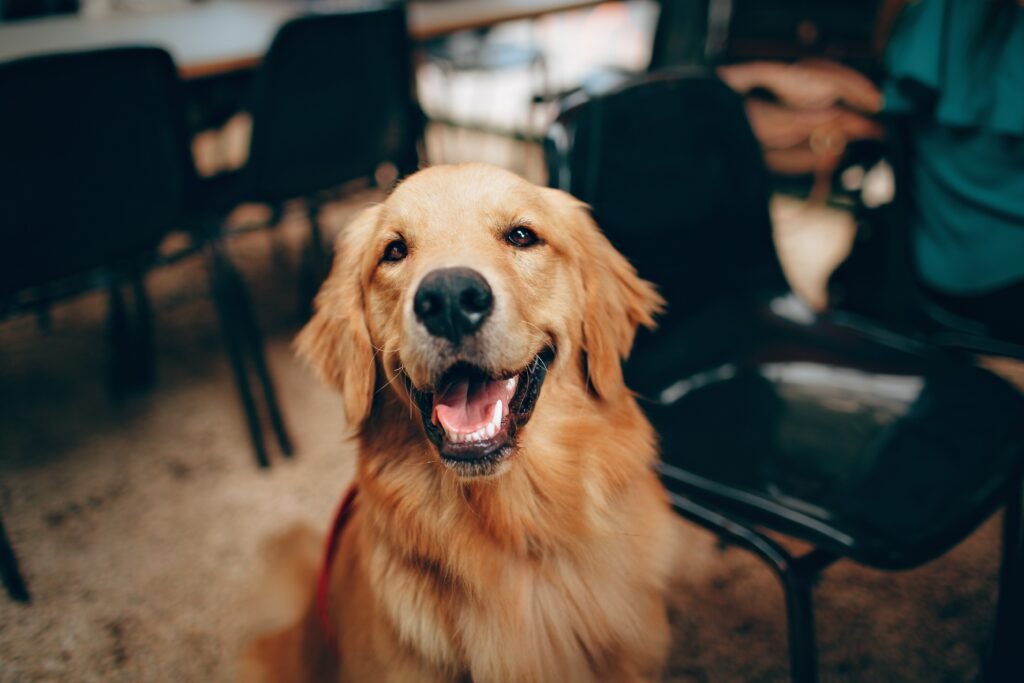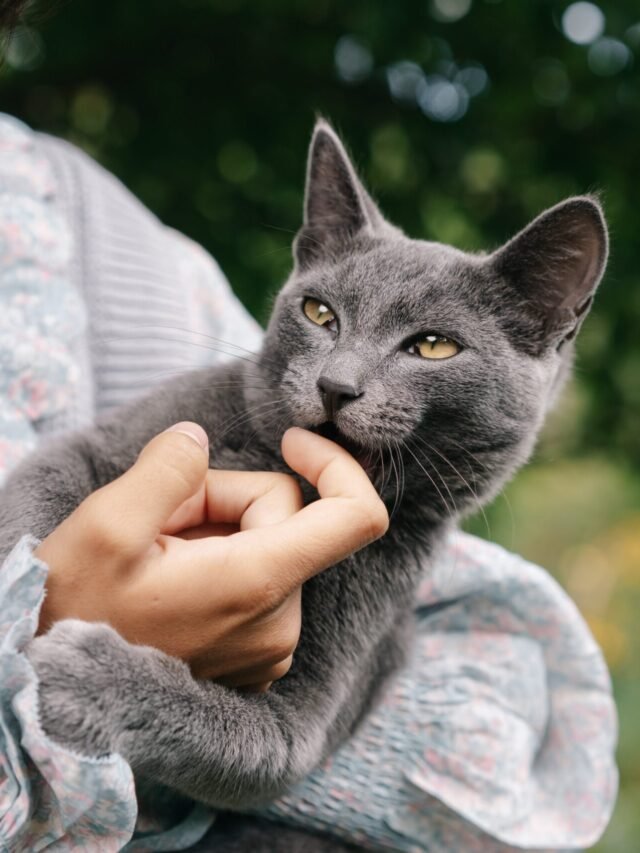The Heart of Gold: Exploring the Golden Retriever Dog Breed, a popular dog breed, hails from Scotland and is cherished for its friendly, loving nature. This medium-sized breed is known for its loyalty and zest for life. They excel in various roles, from hunting and guiding the blind to assisting in search-and-rescue missions and field work.
Golden Retrievers boast a robust, muscular physique and a gleaming golden coat that defines their name. Males typically stand at 23 to 24 inches in height, while females reach 21.5 to 22.5 inches. In terms of weight, females range from 55 to 75 pounds, and males from 65 to 75 pounds. These delightful dogs tend to live for 10 to 12 years.
Table of Contents
What is the history of Golden Retriever?
The history goes back to Scotland in the late 19th century. They were originally bred by Sir Dudley Marjoribanks, who later became Baron Tweedmouth. He mixed Flat-coated Retrievers with Tweed Water Spaniels, and also added some Red Setter, Labrador Retriever, and Bloodhound bloodlines. These dogs were primarily created for hunting and fetching game birds, especially waterfowl.
The Golden Retrievers were officially recognized by The Kennel Club of England in 1911. They made their way to North America in the early 20th century, serving both as hunting dogs and beloved companions. Today, they are among the most popular dog breeds in the United States and are often employed as service dogs, guide dogs, and search and rescue dogs.
If you’re thinking about adopting or buying a Golden Retriever, you can find more information about breeders and adoption centres on the American Kennel Club’s website.
What is the temperament of a Golden Retriever?
The personality is truly exceptional. They are known for being friendly, gentle, and smart. These dogs love to play, especially with kids, and they usually get along well with other pets and even strangers. What’s even more impressive is their eagerness to please, which makes them excellent at obeying commands and ideal for service roles.
Golden Retrievers are generally calm, but they have moments of high energy. They are not the aggressive or confrontational type. Instead, they see life as a shared social adventure
How do I train?
Training your Golden Retriever is a step-by-step process that requires patience, consistency, and positive rewards. Here are some tips to get you started:
Begin Early: Start teaching your Golden Retriever when they’re a puppy. Puppies are quick learners and more trainable than adult dogs.
Stay Consistent: Use the same commands and rewards every time you train. This helps your dog understand what’s expected and what they’ll get in return.
Positive Rewards: Encourage good behaviour with treats, praise, or playtime. This motivates them to repeat the right actions.
Socialise: Introduce your Golden Retriever to various people, animals, and places. This builds their confidence and adaptability.
Patience: Remember that dog training takes time and effort. Don’t be disheartened if your dog doesn’t grasp things immediately.
How do I potty train?
To house train your Golden Retriever, you’ll need patience, consistency, and positive reinforcement. Here are some steps to start with:
Set a Routine: Create a regular schedule to help your puppy learn when and where to go. Use an alarm to remind you to take your puppy outside. Praise and reward them when they succeed.
Positive Rewards: Encourage good behaviour with treats, praise, or playtime. This motivates your puppy to repeat the right actions.
Supervise and Confine: Keep a close eye on your puppy and restrict them to a small area when you can’t watch them. This reduces the chances of accidents.
Watch for Signals: Pay attention to signs that your puppy needs to go, like sniffing around or circling. Take them outside immediately when you notice these cues.
Proper Cleanup: If there are accidents, clean them thoroughly to remove the scent and discourage your puppy from using the same spot.

How do I crate train?
Crate training your Golden Retriever takes time, consistency, and positive methods. Here’s a simple guide to get you started:
Introduction: Begin by slowly introducing your Golden Retriever to the crate. Place it in a common area with the door open, allowing them to explore it at their own pace.
Make It Cosy: Add a comfy bed, blanket, and some of their favourite toys or treats to the crate to make it inviting.
Use Positive Rewards: Encourage your dog to enter the crate with treats, praise, or playtime. This creates a positive association with the crate.
Gradual Progress: Start with short periods in the crate while you’re at home. Gradually extend the time as your dog becomes more comfortable.
Ignore Whining: If your dog whines or cries in the crate, don’t let them out immediately. Wait until they’re quiet to open the door, teaching them that whining doesn’t work.
No Punishment: Remember, the crate should be a safe and pleasant space for your dog, not a place for discipline or punishment.
How Do I Groom My Golden Retriever Dog Breed?
Grooming your Golden Retriever is vital for their health and happiness. Here are some easy grooming tips:
Brushing: Brush your Golden’s coat weekly to remove loose hair and prevent mats. A slicker or pin brush works well for their thick fur.
Bathing: Bathe your dog every 2-3 months or when needed. Use dog-specific shampoo and conditioner, ensuring a thorough rinse to avoid skin irritation.
Nail Care: Trim your dog nails every 4-6 weeks to prevent overgrowth and discomfort. Be cautious not to cut the quick (the pink part).
Ear Cleaning: Clean their ears weekly using a dog-specific ear cleaning solution and cotton balls. Wipe away dirt and debris, but don’t insert anything into the ear canal.
Dental Health: Brush your Golden’s teeth daily with dog-specific toothbrush and toothpaste to prevent gum disease and tooth decay.
For more detailed grooming instructions, visit the American Kennel Club’s website or consult your veterinarian.
What are some common health problems?
Golden Retrievers are usually healthy, but, like all breeds, they can face specific health concerns. Some common health problems in Golden Retrievers include:
Cancer: Golden Retrievers have a higher risk of cancer, including hemangiosarcoma, lymphosarcoma, osteosarcoma, and mastocytoma.
Hip and Elbow Dysplasia: This genetic condition affects their joint health, potentially leading to pain, lameness, and arthritis.
Eye Conditions: Golden Retrievers can experience eye issues like cataracts, progressive retinal atrophy (PRA), and glaucoma.
Skin Allergies: These allergies may cause itching, redness, and hair loss.
Ear Infections: Their long ears can trap moisture and debris, making them more susceptible to ear infections.
If you’re thinking about getting a Golden Retriever, it’s essential to be aware of these potential health problems. Regular vet check-ups can help catch issues early, ensuring your dog’s continued health and happiness.
How long do Golden Retrievers live?
Golden Retrievers are known for their relatively long lifespans. On average, these beloved dogs typically live around 10 to 12 years. Yet, with dedicated care and a healthy lifestyle, some Golden Retrievers have been known to surpass even 16 years, offering companionship, loyalty, and joy for an extended period. By providing a nurturing environment, regular veterinary check-ups, and a balanced diet, you can significantly contribute to ensuring your Golden Retriever enjoys a long, happy, and healthy life.
What is the average weight?
The typical weight of a Golden Retriever falls within a specific range. Female Golden Retrievers usually weight between 55 to 75 pounds, while their male counterparts generally fall within the range of 65 to 75 pounds. This breed’s weight range is an important consideration for their overall health and well-being, and it’s advisable to monitor your Golden Retriever’s weight to ensure they maintain a healthy and happy life.
How much exercise does a Golden Retriever need?
Golden Retrievers, known for their friendly and gentle nature, are also high-spirited dogs. They need a considerable amount of exercise to keep them healthy and content. The specific exercise requirements for a Golden Retriever depend on factors like age, weight, and overall health.
According to the Golden Retriever Society, Golden Retriever puppies should get about 15-25 minutes of exercise each day. As they grow into adults, they’ll need more physical activity, ranging from 40-120 minutes daily. While they often live as family pets, Golden Retrievers retain their working dog ancestry. Regular exercise is essential for their well-being, as it prevents boredom and unwanted behaviour.
Some activities Golden Retrievers typically enjoy include leisurely walks, jogging, swimming, engaging in a game of fetch, and exploring nature on hikes. It’s crucial to tailor the exercise routine to your individual dog’s needs, and your veterinarian can provide guidance if you’re unsure how to best meet those needs. Proper exercise keeps these furry friends happy, healthy, and well-behaved.
What are some common commands to teach my dog?
Teaching your dog basic commands is a crucial part of their training. These commands ensure better communication and a well-behaved pet. Here are some fundamental commands to teach your dog:
Sit: This is one of the most important and simple commands. To get your dog to sit, hold a treat near their nose and raise it slightly. Their head will follow the treat, causing their bottom to lower. Once they are in a sitting position, say “sit” and reward them with the treat.
Stay: The “stay” command keeps your dog in one place for a short time. Ask your dog to sit, open your palm in front of them, and say “stay.” Step back a bit and wait for a few seconds before returning to reward them with a treat.
Come: “Come” is used to call your dog back to you. Get down to their level and say “come” while gently pulling their leash. Reward them with a treat when they come to you.
Down: To get your dog to lie down, start with them in a sitting position. Hold a treat close to the floor and say “down.” Move the treat along the floor to encourage them to lie down, then reward them with a treat when they do.
Heel: “Heel” is used to make your dog walk beside you without pulling on their leash. Begin by walking with your dog on a loose leash. Say “heel” and turn around, walking in the opposite direction. Reward them with a treat when they walk beside you without pulling.
Off: Use “off” to prevent your dog from jumping on people or furniture. When your dog jumps up, say “off” and gently guide them down while saying “sit.” Reward them with a treat when they sit down.
Leave it: This command keeps your dog from touching or eating something they shouldn’t. Begin by placing a treat in one hand, closing it into a fist, and saying “leave it.” Wait for them to stop showing interest before rewarding them with the treat from your other hand.
Remember that training takes time and patience, so stay positive and patient with your dog. Training is an ongoing process, and every dog learns at their own pace. Good luck with your training efforts!

Are there any famous Golden Retrievers?
Yes, there are indeed famous Golden Retrievers that have captured the public’s attention. Here are a few notable ones:
Tucker Budzyn: Tucker, a Golden Retriever from Michigan, has won the hearts of millions with his entertaining videos. He boasts over 3 million followers on Instagram and 3.48 million subscribers on YouTube.
Charlie: Hailing from Ohio, Charlie is known for his humorous videos featuring his siblings and parents. He has gathered over 1 million followers on Instagram.
Liberty: Liberty was the cherished Golden Retriever of American President Gerald R. Ford.
Rosebud: Rosebud was the Golden Retriever associated with the Air Buddies movie franchise.
Gracie: Gracie was the beloved Golden Retriever of none other than Oprah Winfrey.
These are just a handful of the famous Golden Retrievers out there, with some achieving stardom through social media, while others are the beloved companions of celebrities. Whether it’s social media fame or a special place in history, Golden Retrievers have made their mark.
Types of Golden Retrievers
Golden Retrievers are a single breed of dog, but they come in different styles. The three most common types of Golden Retrievers are:
American: This is the most prevalent type in the United States. They have a slimmer coat and a more streamlined body.
English: Also known as the British Golden Retriever, these Goldens sport a thicker coat and a stockier build compared to their American counterparts. They’re often lighter in colour.
Canadian: This type of Golden Retriever is similar in appearance to the American variety but tends to be taller with a thinner coat.
It’s crucial to understand that these are not distinct breeds but rather variations within the same breed. Additionally, there are other subtypes, including field-bred, show, red, black, and mini Goldens, though they aren’t officially recognized by breed standards.
If you’re considering adopting or purchasing a Golden Retriever, you can find more information on breeders and adoption centres on the American Kennel Club’s website.
Frequently Asked Questions
A: Originated in 19th-century Scotland, created by Sir Dudley Marjoribanks (Baron Tweedmouth). They were bred for hunting game birds, particularly waterfowl. Officially recognized in 1911, they became popular in North America in the early 20th century, serving as both hunting dogs and beloved companions. Today, they’re a leading breed in the U.S. and excel as service, guide, and search and rescue dogs. Visit the American Kennel Club’s website for adoption and breeder information.
A: Training your Golden Retriever is a gradual process that involves patience, consistency, and positive reinforcement. Here’s how to get started:
Begin Early: Start training your Golden Retriever when they’re still a puppy. Puppies are more receptive and easier to train.
Stay Consistent: Use the same commands and rewards during each training session. This helps your dog understand what’s expected and what they’ll receive in return.
Positive Rewards: Motivate good behaviour by rewarding your dog with treats, praise, or playtime. This encourages them to repeat desirable actions.
Socialize: Expose your Golden Retriever to different people, animals, and environments. This helps them build confidence and adaptability.
Patience: Remember that dog training takes time and effort. Don’t be discouraged if your dog doesn’t learn everything right away.
A: House training your Golden Retriever requires patience, consistency, and positive reinforcement. Here are the initial steps to get started:
Set a Routine: Establish a consistent schedule to help your puppy learn when and where to go. Use an alarm as a reminder to take your puppy outside and reward them when they succeed.
Positive Rewards: Encourage good behaviour with treats, praise, or playtime. These incentives motivate your puppy to repeat the right actions.
Supervise and Confine: Keep a close watch on your puppy and confine them to a small area when you can’t supervise. This reduces the likelihood of accidents.
Watch for Signals: Be attentive to signs that your puppy needs to go, such as sniffing around or circling. When you notice these cues, take them outside promptly.
Proper Cleanup: In case of accidents, clean up thoroughly to eliminate the scent and discourage your puppy from using the same spot.
A: Crate training your Golden Retriever involves a patient, consistent, and positive approach. Here’s a straightforward guide to help you start:
Introduction: Begin by introducing your Golden Retriever to the crate slowly. Place the crate in a common area with the door open, allowing them to explore it at their own pace.
Make It Cozy: Enhance the crate’s comfort by adding a soft bed, blanket, and some of their favorite toys or treats. This makes the crate inviting.
Use Positive Rewards: Encourage your dog to enter the crate with treats, praise, or playtime. This creates a positive association with the crate.
Gradual Progress: Start with short periods in the crate while you’re at home, gradually increasing the time as your dog becomes more comfortable.
A: Grooming your Golden Retriever is essential for their well-being. Here are some straightforward grooming tips to follow:
Brushing: Brush your Golden’s coat on a weekly basis to remove loose hair and prevent matting. Opt for a slicker or pin brush to manage their thick fur effectively.
Bathing: Give your dog a bath every 2-3 months or as needed. Use dog-specific shampoo and conditioner, and ensure a thorough rinse to prevent skin irritation.
Nail Care: Trim your Golden’s nails every 4-6 weeks to prevent overgrowth and discomfort. Be careful not to cut the quick (the pink part of the nail).
Ear Cleaning: Clean your dog’s ears on a weekly basis using a dog-specific ear cleaning solution and cotton balls. Wipe away any dirt or debris, but avoid inserting anything into the ear canal.
Dental Health: Brush your Golden’s teeth daily with a dog-specific toothbrush and toothpaste to ward off gum disease and tooth decay.
A: Golden Retrievers can have health problems like cancer, joint issues, eye conditions, skin allergies, and ear infections. Regular vet check-ups are important to keep them healthy and happy.
A: On average, Golden Retrievers typically live around 10 to 12 years. However, with dedicated care and a healthy lifestyle, some Golden Retrievers have been known to surpass even 16 years, offering companionship, loyalty, and joy for an extended period. By providing a nurturing environment, regular veterinary check-ups, and a balanced diet, you can significantly contribute to ensuring your Golden Retriever enjoys a long, happy, and healthy life.
A: The typical weight of a Golden Retriever falls within a specific range. Female Golden Retrievers usually weight between 55 to 75 pounds, while their male counterparts generally fall within the range of 65 to 75 pounds.
A: Golden Retrievers are friendly and spirited dogs. When they’re puppies, they need about 15-25 minutes of exercise daily. As they grow up, that goes up to 40-120 minutes each day. Activities they enjoy include walks, jogging, swimming, playing fetch, and hiking. Remember to adjust their exercise to their individual needs and consult your vet if you’re unsure. Proper exercise keeps them happy and well-behaved.
A: Teaching your dog essential commands is vital for their training and your communication. Here are some fundamental commands to start with
Sit: Teach your dog to sit by holding a treat near their nose, raising it slightly to make their bottom lower, and saying “sit” when they’re in the sitting position.
Stay: Use the “stay” command to keep your dog in one place for a short period. Ask your dog to sit, open your palm in front of them, and say “stay.” Step back and wait before rewarding them.
Come: To call your dog back to you, say “come” while gently pulling their leash. Reward them with a treat when they respond.
Down: Get your dog to lie down by holding a treat near the floor and saying “down.” Encourage them to lie down, then reward them.
Heel: Use “heel” to make your dog walk beside you without pulling on their leash. Turn around when saying “heel” and reward them when they walk calmly beside you.
Off: Prevent your dog from jumping on people or furniture with the “off” command. Guide them down and reward them when they sit down.
Leave it: Teach your dog not to touch or eat something they shouldn’t by saying “leave it” when they show interest. Reward them when they stop.
Remember that dog training takes time and patience. Every dog learns at their own pace. Stay positive and patient during the training process, and good luck!



























